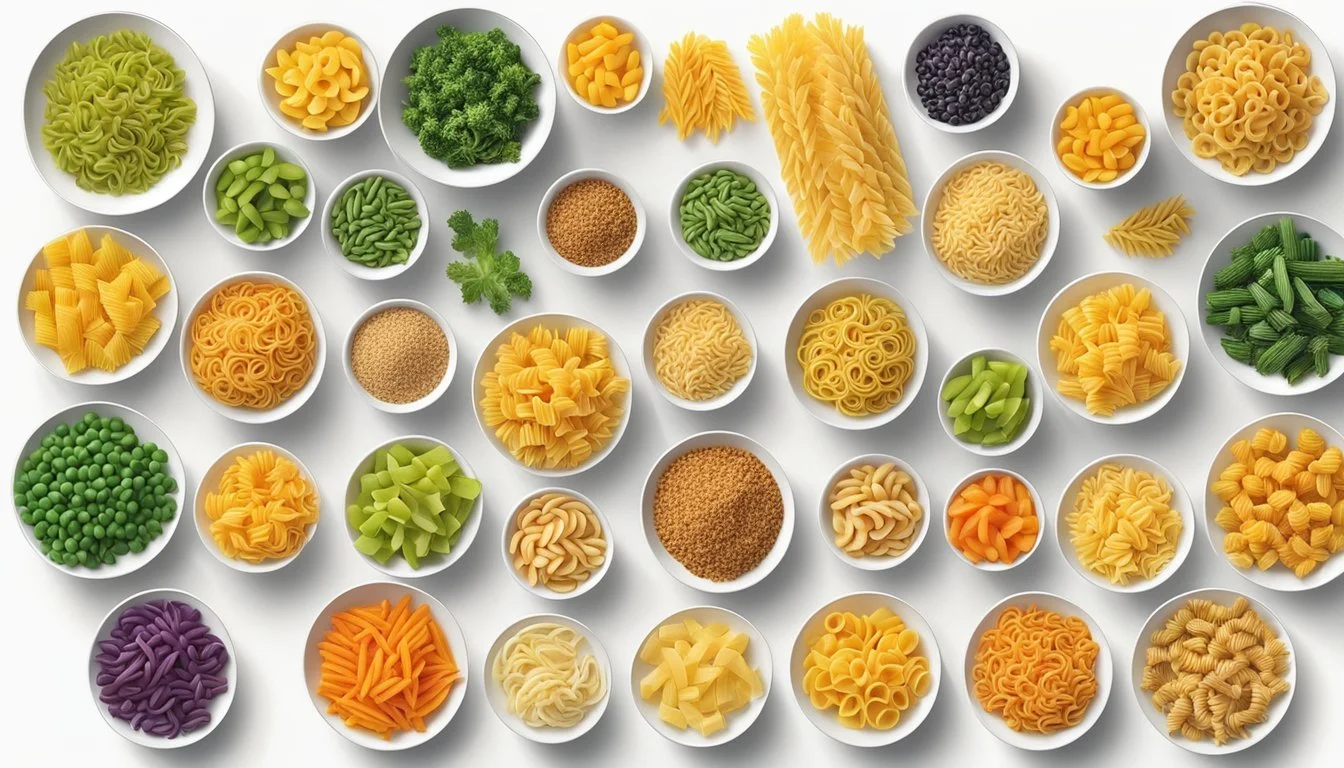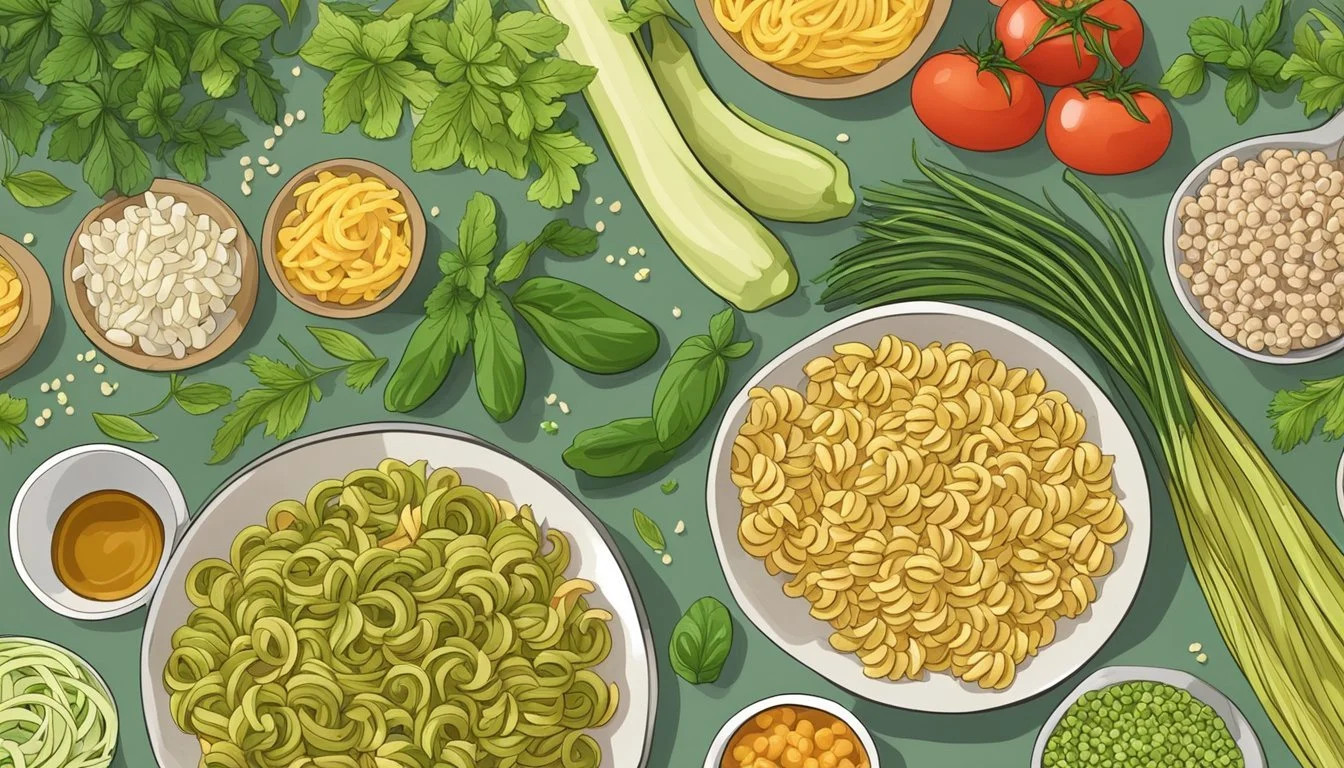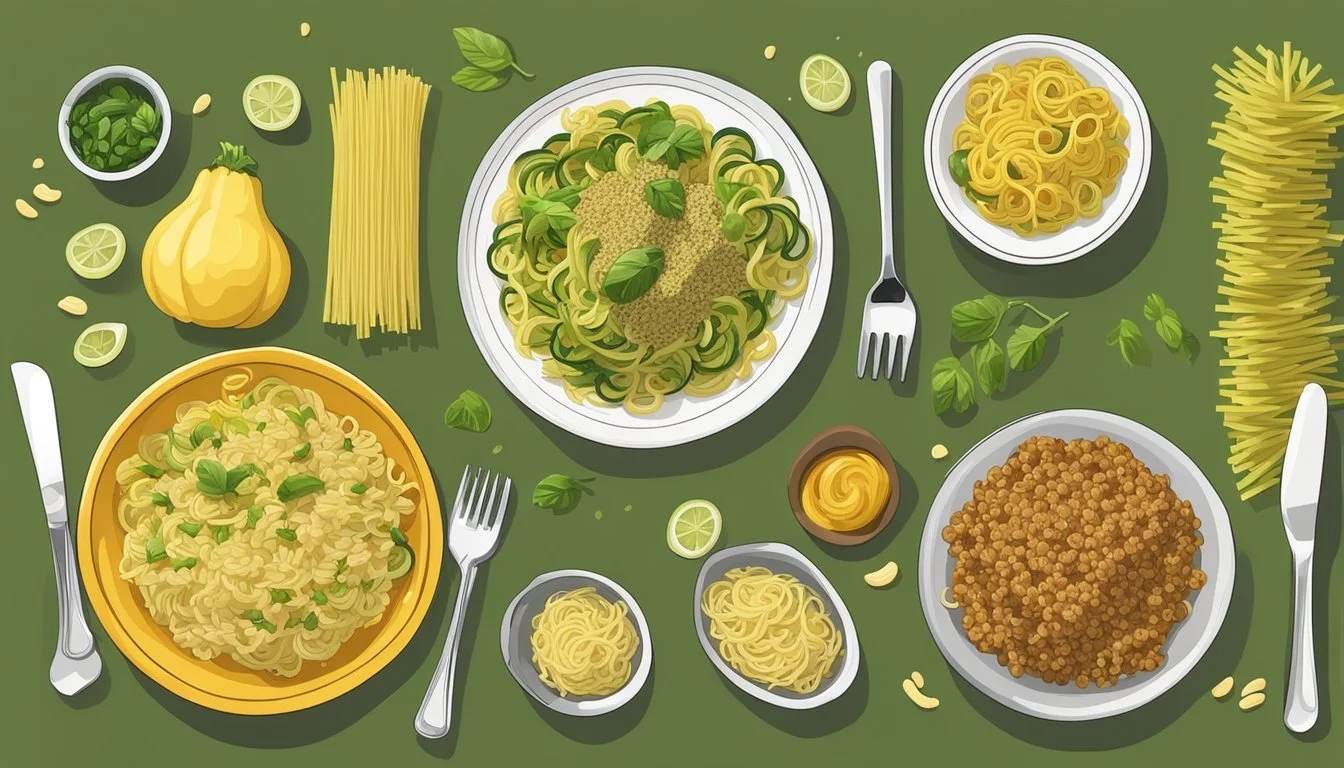Rotini Pasta Substitutes
Top Alternatives for Your Favorite Twists
Rotini pasta is a popular Italian pasta (What wine goes well with pasta?) known for its distinctive spiral shape which effectively holds onto sauces and dressings. A staple in various pasta dishes (What wine goes well with pasta dishes?), from salads to casseroles (What wine goes well with casseroles?), rotini's ridges make it perfect for robust and hearty sauces. However, sometimes a suitable substitute is necessary, either for variety, dietary preferences, or when rotini is not available.
When looking for an alternative, the shape, texture, and flavor of the pasta are important considerations to ensure the dish retains its intended appeal. Substitutes such as fusilli and gemelli are often recommended because they share a similar spiral shape that serves the same purpose in a dish as rotini.
The texture of rotini pasta is another pivotal aspect, as it must be firm enough to maintain its shape during cooking and meld well with other ingredients. To replicate this, pasta substitutes should also offer a resilient texture, and cooking times may need to be adjusted accordingly to achieve an al dente finish. With the vast array of pasta shapes and types available, finding a substitute that complements the flavor of the accompanying sauces and ingredients is both an art and a science.
Understanding Rotini Pasta
Rotini pasta is renowned for its spiral shape, ability to cling to sauces, and its place within the diverse world of Italian pasta. This section delves into the essence of rotini, its distinction from other pasta shapes, and practical cooking tips.
Origin and Characteristics
Rotini, meaning "small wheels" in Italian, features a distinctive corkscrew-like shape with external spirals. This shape originates from Southern Italy and it is traditionally made with semolina flour, which comes from durum wheat. Because of the spirals, it can hold onto various flavors and sauce types, making it well-suited for a variety of dishes.
Rotini vs Other Pasta Shapes
Compared to similar pasta like fusilli, rotini has tighter spirals, which holds sauces effectively. Fusilli pasta usually has a slightly longer cooking time due to being thicker, while rotini takes around 7-10 minutes of boiling to reach the perfect al dente texture.
Fusilli: 10-12 minutes boiling time.
Rotini: 7-10 minutes boiling time.
This allows for easy substitution between rotini and other pasta shapes, especially when considering the type of sauce or the desired texture in a dish.
Cooking Tips for Perfect Rotini
When cooking rotini, it's important to use a large pot of salted, boiling water to avoid the pasta sticking together. Stirring occasionally, cook until al dente to ensure the pasta retains a firm texture. The ideal ratio of water to pasta is:
Water: 4-6 quarts per pound of pasta.
Salt: 1-2 tablespoons per pot.
Due to its design, rotini pasta pairs well with both light and hearty sauces. It's also excellent for baked pasta dishes, cold pasta salads, and casseroles.
Nutritional Profile of Rotini
Rotini pasta, with its distinctive spiral shape, is a versatile pasta that is commonly used in a variety of dishes. When evaluating the nutritional profile of this pasta, it is important to consider the primary ingredient: semolina from durum wheat flour. A typical serving of rotini, which is about 56 grams (or 2 ounces) of dry pasta, usually contains:
Calories: Approximately 200 kcal
Protein: Around 7 grams
Total Fat: Generally 1 gram or less
Carbohydrates: Roughly 42 grams
Dietary Fiber: About 2 grams
For those opting for a whole wheat variety, whole wheat rotini offers a different nutritional profile, often higher in fiber due to the inclusion of the whole grain. For instance, the dietary fiber content may increase to as much as 6 grams per serving. Whole wheat versions also provide a slightly enhanced protein content and a richer array of micronutrients due to the presence of the wheat germ and bran.
For individuals requiring a gluten-free diet, rotini can be found made from alternative flours like brown rice or other gluten-free blends. The gluten-free rotini, which often includes ingredients such as brown rice flour or even legume flours, consists of a varied nutrient composition. Brown rice pasta may offer:
Calories: Comparable to traditional rotini, typically around 200 kcal per serving
Protein: Varies, sometimes slightly lower than traditional pasta
Total Fat: Usually similar to traditional rotini
Carbohydrates: Often similar, but the source is rice rather than wheat
Dietary Fiber: Can be comparable or slightly higher depending on the specific product
It is crucial to note that the exact nutritional values can vary by brand and specific product formulation, and consumers are advised to reference the nutrition label on the packaging for precise information.
Substitutes Based on Shape and Texture
When selecting substitutes for rotini pasta, one must consider variants that mimic rotini's spiral shape and firm texture to ensure that sauces cling to the pasta similarly.
Fusilli Pasta
Fusilli presents a spiral shape akin to rotini, often with a slightly tighter corkscrew pattern. Its twists allow sauces and dressings to adhere well, maintaining a consistency in flavor and experience. Since fusilli has a similar shape and texture, it acts as a seamless alternative in most dishes that call for rotini.
Cavatappi and Gemelli
Cavatappi and Gemelli are both excellent substitutes, delivering a comparable tactile feel with their corkscrew-like design. Cavatappi's elongated and hollow spirals provide a firmer texture perfect for heavier sauces while Gemelli, characterized by its double-twisted shape resembling two strands of pasta wrapped around one another, offers a similar firm bite as rotini.
Radiatore and Macaroni
With its ridged surfaces, Radiatore captures sauce effectively, making it a good alternative to rotini, especially in textured pasta salads or casseroles. Macaroni, particularly the more tubular and ridged varieties, can also replace rotini where the pasta's ability to hold sauces is preferred, despite having a less defined spiral shape. The texture of both radiatore and macaroni can complement the textures found in dishes that typically use rotini.
Considering Sauce Pairings
When selecting a substitute for rotini pasta, it is crucial to consider how well the alternative will complement and interact with the sauce used in the dish.
Classic Pasta Dishes
Rotini pasta is renowned for its compatibility with a range of sauces, serving as a staple in many classic pasta dishes. For example:
Pesto: Traditional rotini pairs beautifully with pesto due to its spiral shape, which traps the sauce. If substituting, one should opt for pastas with nooks and ridges like fusilli or trofie.
Marinara: A simple tomato-based sauce like marinara clings well to rotini. Substitutes such as penne or farfalle also work well due to their surface area and shapes conducive to light tomato coatings.
Sauce Absorption and Pasta Texture
The shape and texture of the pasta influence sauce absorption and the overall mouthfeel of a dish.
Tomato-Based Sauces: These sauces, which range from light marinara to more robust preparations, pair well with pastas that have grooves or holes to capture the sauce, like rotini. Substitutes with similar features include penne or conchiglie.
Creamy and Cheese Sauces: Cream, alfredo, or cheese-based sauces require pasta that can support their weight and richness. When replacing rotini, one should look for pastas like rigatoni or cavatappi, which possess ample surface to bind with creamy textures.
In conclusion, the interaction between pasta and sauce is complex, and choosing the right substitute for rotini involves a balance of texture, shape, and the sauce's density.
Alternative Dietary Options
When exploring alternatives to traditional rotini pasta, diners have a variety of gluten-free and vegetable-based options that cater to dietary restrictions or nutritional preferences.
Gluten-Free and Whole Grain Pastas
For those avoiding gluten, brown rice pasta is a popular choice that mirrors the texture and cooking time of traditional pasta. Made primarily from rice flour, this alternative provides a chewy consistency and a neutral flavor, making it versatile for a range of sauces and recipes.
Another excellent gluten-free option is shirataki noodles, which are composed of a fiber known as glucomannan, derived from the konjac root. These noodles are almost zero-calorie and carb-free, making them suitable for low-carb diets.
Pasta made from quinoa flour offers a nutrient-rich experience, as quinoa is known for its high protein content as well as its valuable minerals and vitamins. These pastas combine quinoa with other gluten-free flours to create a firm texture akin to wheat pasta.
Vegetable-Based Substitutes
Zucchini can be transformed into noodle-like strands known as "zoodles" using a spiralizer. These vegetable substitutes are not only low in calories but also offer the freshness and nutritional benefits of consuming whole vegetables.
Vegetable-based Substitutes Calories (approx. per cup) Carbohydrates Spiralized Zucchini (Zoodles) 20 4g Spiralized Butternut Squash 45 12g
For those looking for a variety of textures, spiralized vegetables from squash to carrots can mimic different types of pasta. They allow for creativity and can be eaten raw, lightly sautéed, or boiled to achieve a texture similar to al dente pasta.
Rice noodles, a staple in Asian cuisine, offer a gluten-free alternative that absorbs flavors well. Made from rice flour and water, they are versatile for both hot and cold dishes, often served in soups or spring rolls.
Color and Presentation
When considering Rotini Pasta substitutes for visual appeal, color and presentation are paramount. Choosing a colorful pasta can transform a dish from ordinary to extraordinary, and pasta salads benefit from an array of hues offered by different pasta and vegetable combinations.
Choosing Colorful Pasta Substitutes
For diners looking to infuse vibrancy into their meals, tri-color rotini is an excellent choice. Each color in tri-color rotini typically comes from natural ingredients such as spinach, tomato, and beetroot, which contribute not only distinct shades but also subtle flavor enhancements. When selecting a substitute, one may consider vegetable-infused pastas or naturally dyed alternatives. These substitutes not only mimic the desired spiral shape of rotini but also add a dash of color to any plate.
Spinach pasta for a rich green hue
Beetroot pasta for a deep red or purple tone
Carrot pasta introducing a bright orange touch
Squid ink pasta offering a bold black option
It's important for consumers to note that the cooking times may vary with different substitutes and should be adjusted accordingly.
Creating Attractive Pasta Salads
Pasta salads are visually enhanced by using colorful pasta as a base. The varied colors of the noodles serve as a backdrop that complements vibrant vegetables like bell peppers, cherry tomatoes, purple cabbage, and carrots. In addition to color, these ingredients contribute a variety of textures and flavors.
Consider the following combinations for an eye-catching pasta salad:
Bell peppers: Red, yellow, and green, diced or julienned
Cherry tomatoes: Halved for a pop of red and juiciness
Purple cabbage: Shredded for a crunchy purple contrast
Shredded carrots: For a splash of orange and additional crunch
When assembling a pasta salad, it's crucial to mix these colorful ingredients evenly to ensure each serving is as appealing as it is tasty. Fresh herbs can also be sprinkled on top for an added element of color and freshness.
Brands and Variants of Substitutes
When looking for rotini pasta substitutes, consumers have various brands and varieties to consider. The following subsections detail some of the top contenders by brand and the different substitute varieties available.
Top Rotini Substitutes by Brand
Different brands offer high-quality rotini pasta substitutes catering to various dietary preferences and needs.
Barilla: Known for a wide range of pasta, Barilla offers options such as whole grain and gluten-free rotini that maintain a similar texture and flavor profile to traditional pasta.
Tinkyada: They specialize in rice pasta, providing a brown rice rotini that is wheat and gluten-free, perfect for those with allergies or on a gluten-free diet.
Jovial: This brand is celebrated for its artisanal and organic pasta varieties, including a gluten-free brown rice rotini that boasts a firm texture suitable for a variety of pasta dishes.
Exploring Different Varieties
Aside from brand-specific substitutes, there are various pasta substitute varieties that echo the spiral shape and texture of rotini.
Quinoa Pasta: A protein-packed alternative with a nutty flavor and a firm texture that stands up well in pasta salads and casseroles.
Brown Rice Pasta: A whole grain option that offers a chewier texture and is a good source of fiber. It’s an ideal choice for those seeking a substitute close to traditional pasta in consistency.
Legume-based Pasta: Made from beans, lentils, or chickpeas, this variant is rich in protein and fiber, bringing a unique taste and a heartier feel to dishes.
Pairing Substitutes With Meals
When considering pasta substitutes for different dishes, it's essential to choose options that complement the meal's texture and flavor profile.
Substitutes for Baked Pasta Dishes
For baked pasta dishes that typically feature meat and robust sauces, Gemelli pasta stands out as an excellent substitute for rotini. Its intertwined spirals hold onto sauces well, making it ideal for baked ziti or a hearty casserole. Another suitable option is brown rice pasta, which offers a pleasant bite and is a healthier choice due to its whole-grain content. Here's a quick guide:
Baked Ziti or Casseroles: Gemelli, Brown Rice Pasta
Lasagna or Stuffed Pasta: Use no-boil lasagna sheets or thinly sliced zucchini for a gluten-free option.
Best Picks for Salads and Soups
Salads and soups require pasta substitutes that maintain their shape and texture when mixed with dressings or when simmered in broth.
For salads, spiralized vegetables like zucchini or cucumbers can be a refreshing alternative, mimicking the twirls of pasta and adding a crisp texture.
In soups, substitutes need to withstand the cooking process without becoming mushy. Rice noodles or shirataki noodles perform well in broth-based soups due to their ability to absorb flavors while holding their shape.
Here's a simple alignment:
Cold Pasta Salads: Spiralized Vegetables, Kelp Noodles
Broth-based Soups: Rice Noodles, Shirataki Noodles
By selecting the right pasta substitute, one can ensure the meal retains its intended deliciousness, whether it's a rich baked dish or a light salad or soup.









